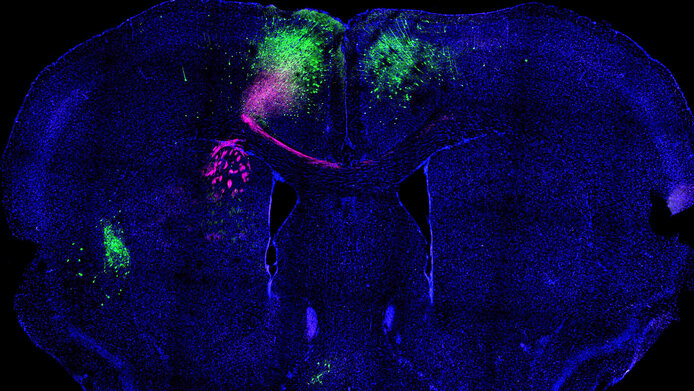Becoming a mother: purely matter of instinct or learning process?

The birth of a child needs to be well prepared. For the parents, this means selecting a baby carriage and setting up the crib. At the same time, the mother's body starts preparing for the new life: hormones such as oestrogen and progesterone stimulate her brain to adjust in order to make the mother more sensitive to the needs of the child. Together with the intense surge of hormones that accompanies birth, this adjustment triggers the maternal instinct. However, despite the joy that the birth of a child brings, almost one in every six mothers is affected by postpartum depression – which may be a result of something not working properly in the physiological adjustments in the brain. An FWF-funded research project has now been able to show that there may be a way out of this situation. The researchers found an alternative means of anchoring maternal care in the brain: via experience.
One can learn to be a mother
Daniela Pollak, a neuroscientist and professor of behavioral biology at the Medical University of Vienna, conducts research on how the maternal care instinct develops. “Like all young mammals, human babies depend on an adult taking care of them. For a long time, researchers have assumed that hormonal changes in a woman's body are necessary for her to develop caring behavior,” says Pollak. “But there are examples to the contrary both in humans and in the animal kingdom: adoptive parents, wet nurses or caring relatives, for example.”
In a project funded by the Austrian Science Fund FWF, Pollak is investigating this exception in female mice that were not pregnant but were called upon to care for baby animals they were given. Her team discovered a new neuronal circuit for caring in these animals and therefore came to the conclusion: motherliness can be learned! If the discovery is also confirmed for humans, this would pave the way for targeted therapies for postpartum disorders.
Contact promotes nurture
“Our findings suggest that caring behavior can be stimulated even if it is not initially physiologically present,” explains Pollak. “It can develop, for example, when mothers copy the behavior of other mothers. But it also works without role models through repeated contact with offspring.” Even if Pollak's analyses are based on the behavior of mice, they do allow at least rough conclusions about humans. “The brain regions responsible for reproductive and caring behavior have been strongly conserved over the course of evolution,” notes Pollak. Accordingly, similarities exist between the behaviors of different mammal species.
Experience makes up for instinct
The devoted caregiving of female mice is expressed, for example, by “pup retrieval” – the frantic picking up and returning of the young to the safe nest when they are outside. “We were interested in the behavior of females that were not previously pregnant and then came into contact with unfamiliar young. We placed these animals in a cage with young that were placed away from the nest and observed the pup retrieval behavior of the females,” Pollak describes the experimental setup. “At first, the females didn't seem to know what to do. But by the third day, their behavior no longer differed from that of biological mothers.”
The reason for the steep learning curve was a previously unknown connection between nerve cells. The contact between the females and the young strengthened an additional communication loop in the animals' brains between the prefrontal cortex (which is considered the control center) and a core area in the thalamus (an old brain area in terms of evolution). Interestingly, this only happened in mice that first had to learn to be mothers and not in the biological mothers. The researchers were thus able to show that experience can compensate for a lack of instinct.
Lighting up neuronal axes
In order to identify this neuronal circuit, Pollak's team used viral tracing, a method in which researchers can introduce harmless, fluorescent viruses at one end of a neuronal pathway and trace them to the other end by means of light. In this case, the axis formed a feedback mechanism between the aforementioned brain regions that regulates the activity of certain nerve cells for maternal behavior.

Results potentially useful for therapeutic purposes
“Even more importantly, we were able to show in a second experiment that the caring behavior is causally linked to the nerve cells we identified,” explains Pollak. For this purpose, the team artificially activated the circuit with the result that the mice learned to be caring more quickly. However, stimulating the connections in this way in human brains is currently still in the realm of pure theory. “Our idea is to determine the nerve cells of the connection at a molecular level. If we were to find a type of receptor that only occurs on these cells, one could develop corresponding drugs,” says Pollak.
Until such time, however, the researcher hopes that the results will have psychotherapeutic benefits. “We now know that the circuit can be stimulated by learning. This offers an option to all those mothers who lack a physiological bond with their child.” Through repeated contact with the child and learning from others, they can train their brain to make them behave like a mother.
And the fathers?
There are research findings that show that men’s brains also adapt in preparation for fatherhood. “Our analyses have, however, not furnished any evidence of this axis being active in male animals,” says Pollak. “We are now working on a follow-up study to investigate this in more detail, since the circuit is, of course, also anatomically present in male mice. If it does not fulfil this function, then it must have some other use.”
Personal details
Daniela Pollak studied veterinary medicine and obtained her doctorate in medical science. After a research stay at Columbia University in New York, she returned to the Medical University of Vienna. In 2016 she was appointed Professor of Behavioral Biology there and heads a research team in the Department of Neurophysiology and Neuropharmacology. Pollak conducts research into the neurobiological basis of psychiatric disorders - particularly in relation to reproduction and caring behavior. The project “Neuronal circuits of learned caring behavior” runs until December 2024 and is funded by the Austrian Science Fund FWF with 399,954 euros.
Publication
Glat M., Gundacker A., Cuenca Ric L., Czuczu B., Ben-Simon Y., Harkany T., Pollak DD.: An accessory prefrontal cortex-thalamus circuit sculpts maternal behavior in virgin female mice, in: The EMBO Journal 2022





